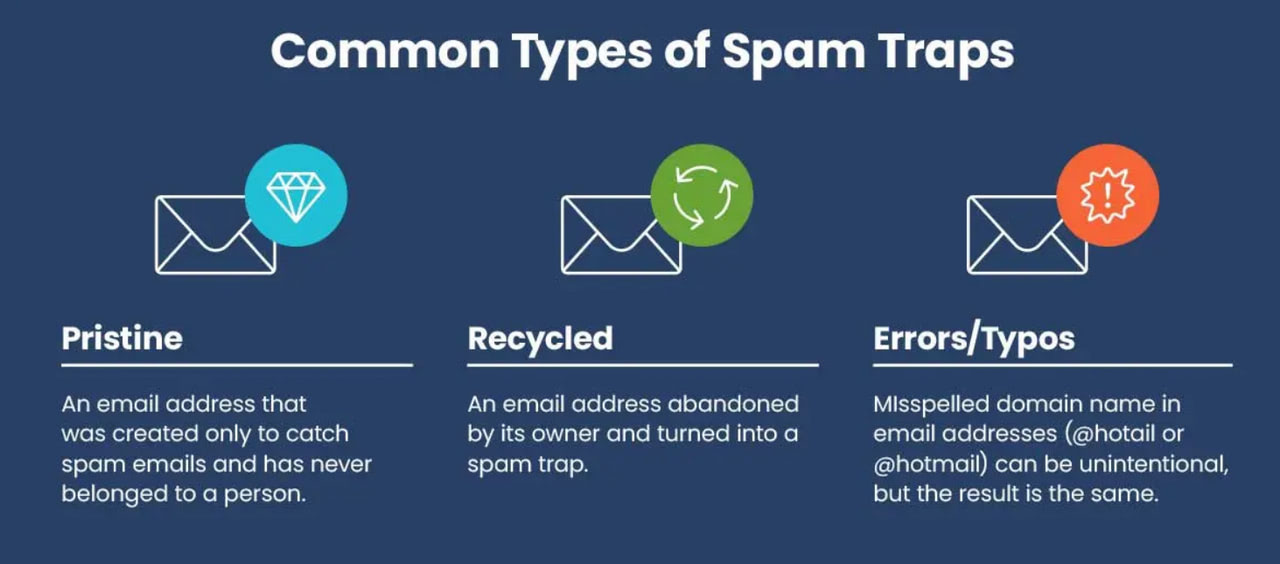Summary
If your agency's IP addresses and domain find themselves on a Spamhaus blocklist, it can be a critical blow to your email deliverability, preventing your clients' messages from reaching their inboxes. This situation is particularly challenging for agencies managing email for numerous companies, as identifying the root cause across a shared infrastructure can be complex. Resolving a Spamhaus blocklist (or blacklist) requires a systematic approach, focusing on identification, rectification, and proactive measures to prevent future listings. Ignoring the issue will only prolong email delivery problems and damage your sender reputation.
Key findings
- General replies: Spamhaus may initially provide general reasons for a listing, such as a lack of confirmed opt-in enforcement, which requires further investigation by the agency.
- Domain listing impact: If your agency's click-tracking domain is listed, it strongly suggests that multiple clients or campaigns are generating spam, not just a single offender.
- Shared infrastructure challenges: Using shared IP addresses across many clients makes it difficult to pinpoint the specific customer or campaign causing the blacklisting without detailed data from Spamhaus.
- Bot activity: Spamhaus robots might follow links, including those used for confirmed opt-in verification, potentially flagging legitimate processes if not properly secured with bot detection.
Key considerations
- Proactive contact: Engage with Spamhaus through their delisting process. They often provide helpful, specific details if you inquire directly about how to get delisted.
- Isolate the source: Request specific information like From addresses or subject lines to identify which client is causing the issue. This is crucial for agencies with many clients.
- Address underlying issues: Prioritize fixing the root cause of the spamming before requesting delisting. Spamhaus expects you to resolve the problem first. Understand what causes Spamhaus blocklisting.
- Implement separate domains/subdomains: Consider using distinct subdomains or even separate domains for each client. This can help isolate potential blacklisting issues to individual clients rather than affecting your entire agency's reputation. You can check your status on the official Spamhaus Blocklist Removal Center.
 Spamhaus
Spamhaus 0Spam
0Spam Cisco
Cisco NoSolicitado
NoSolicitado URIBL
URIBL abuse.ro
abuse.ro ALPHANET
ALPHANET Anonmails
Anonmails Ascams
Ascams BLOCKEDSERVERS
BLOCKEDSERVERS Calivent Networks
Calivent Networks EFnet
EFnet
 JustSpam
JustSpam Kempt.net
Kempt.net
 NordSpam
NordSpam RV-SOFT Technology
RV-SOFT Technology
 Scientific Spam
Scientific Spam Spamikaze
Spamikaze SpamRATS
SpamRATS SPFBL
SPFBL Suomispam
Suomispam System 5 Hosting
System 5 Hosting Team Cymru
Team Cymru Validity
Validity www.blocklist.de Fail2Ban-Reporting Service
www.blocklist.de Fail2Ban-Reporting Service ZapBL
ZapBL 2stepback.dk
2stepback.dk Fayntic Services
Fayntic Services ORB UK
ORB UK technoirc.org
technoirc.org TechTheft
TechTheft Spamhaus
Spamhaus 0Spam
0Spam Cisco
Cisco NoSolicitado
NoSolicitado URIBL
URIBL abuse.ro
abuse.ro ALPHANET
ALPHANET Anonmails
Anonmails Ascams
Ascams BLOCKEDSERVERS
BLOCKEDSERVERS Calivent Networks
Calivent Networks EFnet
EFnet
 JustSpam
JustSpam Kempt.net
Kempt.net
 NordSpam
NordSpam RV-SOFT Technology
RV-SOFT Technology
 Scientific Spam
Scientific Spam Spamikaze
Spamikaze SpamRATS
SpamRATS SPFBL
SPFBL Suomispam
Suomispam System 5 Hosting
System 5 Hosting Team Cymru
Team Cymru Validity
Validity www.blocklist.de Fail2Ban-Reporting Service
www.blocklist.de Fail2Ban-Reporting Service ZapBL
ZapBL 2stepback.dk
2stepback.dk Fayntic Services
Fayntic Services ORB UK
ORB UK technoirc.org
technoirc.org TechTheft
TechTheft Spamhaus
Spamhaus 0Spam
0Spam Cisco
Cisco NoSolicitado
NoSolicitado URIBL
URIBL abuse.ro
abuse.ro ALPHANET
ALPHANET Anonmails
Anonmails Ascams
Ascams BLOCKEDSERVERS
BLOCKEDSERVERS Calivent Networks
Calivent Networks EFnet
EFnet
 JustSpam
JustSpam Kempt.net
Kempt.net
 NordSpam
NordSpam RV-SOFT Technology
RV-SOFT Technology
 Scientific Spam
Scientific Spam Spamikaze
Spamikaze SpamRATS
SpamRATS SPFBL
SPFBL Suomispam
Suomispam System 5 Hosting
System 5 Hosting Team Cymru
Team Cymru Validity
Validity www.blocklist.de Fail2Ban-Reporting Service
www.blocklist.de Fail2Ban-Reporting Service ZapBL
ZapBL 2stepback.dk
2stepback.dk Fayntic Services
Fayntic Services ORB UK
ORB UK technoirc.org
technoirc.org TechTheft
TechTheft Spamhaus
Spamhaus 0Spam
0Spam Cisco
Cisco NoSolicitado
NoSolicitado URIBL
URIBL abuse.ro
abuse.ro ALPHANET
ALPHANET Anonmails
Anonmails Ascams
Ascams BLOCKEDSERVERS
BLOCKEDSERVERS Calivent Networks
Calivent Networks EFnet
EFnet
 JustSpam
JustSpam Kempt.net
Kempt.net
 NordSpam
NordSpam RV-SOFT Technology
RV-SOFT Technology
 Scientific Spam
Scientific Spam Spamikaze
Spamikaze SpamRATS
SpamRATS SPFBL
SPFBL Suomispam
Suomispam System 5 Hosting
System 5 Hosting Team Cymru
Team Cymru Validity
Validity www.blocklist.de Fail2Ban-Reporting Service
www.blocklist.de Fail2Ban-Reporting Service ZapBL
ZapBL 2stepback.dk
2stepback.dk Fayntic Services
Fayntic Services ORB UK
ORB UK technoirc.org
technoirc.org TechTheft
TechTheft Spamhaus
Spamhaus 0Spam
0Spam Cisco
Cisco NoSolicitado
NoSolicitado URIBL
URIBL abuse.ro
abuse.ro ALPHANET
ALPHANET Anonmails
Anonmails Ascams
Ascams BLOCKEDSERVERS
BLOCKEDSERVERS Calivent Networks
Calivent Networks EFnet
EFnet
 JustSpam
JustSpam Kempt.net
Kempt.net
 NordSpam
NordSpam RV-SOFT Technology
RV-SOFT Technology
 Scientific Spam
Scientific Spam Spamikaze
Spamikaze SpamRATS
SpamRATS SPFBL
SPFBL Suomispam
Suomispam System 5 Hosting
System 5 Hosting Team Cymru
Team Cymru Validity
Validity www.blocklist.de Fail2Ban-Reporting Service
www.blocklist.de Fail2Ban-Reporting Service ZapBL
ZapBL 2stepback.dk
2stepback.dk Fayntic Services
Fayntic Services ORB UK
ORB UK technoirc.org
technoirc.org TechTheft
TechTheftWhat email marketers say
Email marketers often face unique challenges when their shared IP addresses or agency domains are blocklisted by Spamhaus. The difficulty lies in pinpointing the exact source of the problem among numerous client accounts and navigating the delisting process effectively. Many marketers express a desire for more granular feedback from blocklist providers to streamline troubleshooting and ensure service continuity for their legitimate clients.
Key opinions
- Difficulty in identifying offenders: Agencies find it challenging to identify the specific client or campaign causing the spam issue when operating with shared IPs or when only their agency's tracking domain is listed.
- Desire for specific data: Marketers wish Spamhaus would provide more direct information, such as the sender's domain or specific email content, to help isolate and address the problem quickly.
- Frustration with domain listing: There is a common sentiment that Spamhaus should block the individual sender's domain (the client's) rather than the agency's overarching domain, especially for elements like click-tracking URLs.
- Need for prompt resolution: Getting off a blocklist quickly is paramount to minimize disruption to client email campaigns and preserve the agency's reputation.
Key considerations
- Strong anti-spam policy: Agencies should establish and rigorously enforce a clear anti-spam policy with all clients, outlining acceptable sending practices to prevent abuse.
- Segmentation strategy: When managing multiple clients, consider setting up dedicated IPs or subdomains for each client, especially those with high volume or potentially risky sending habits. This can help isolate issues, as discussed in Spamhaus CSS and DBL issues.
- Data collection review: Scrutinize client data collection processes to ensure that all recipients have truly opted in. A common reason for blocklisting is sending to addresses that never subscribed.
- Persistent monitoring: Actively monitor your IPs and domains for blacklisting to catch problems early. If you're listed on Spamhaus and other blocklists, a comprehensive strategy is needed. Many blacklists have a manual request process.
Marketer view
Email marketer from Email Geeks explains they have contacted Spamhaus, but have only received general replies indicating issues with confirmed opt-in requirements.
Marketer view
An agency owner from Email Geeks states they are a reseller managing clients' email sending accounts with authenticated domains and list verification, yet their shared IPs are blocklisted.
What the experts say
Deliverability experts emphasize that a Spamhaus listing is a symptom of underlying issues that must be resolved before delisting can occur. They highlight the importance of understanding Spamhaus's detailed feedback, especially for shared sending environments, and developing robust policies to prevent recurrence. The evolving nature of blocklist detection, including the potential for bots to interact with verification links, adds another layer of complexity that experts are actively discussing.
Key opinions
- Fix issues first: It's premature to request delisting from Spamhaus before thoroughly fixing the underlying problems that led to the blocklisting.
- Multiple senders likely: If an agency's domain (especially click domains) is listed, it's highly probable that multiple clients are contributing to the spam, not just one.
- Spamhaus provides details: Spamhaus is generally helpful and can provide specific details like From addresses and subject lines to help identify offending senders.
- Bot interaction with COI: There is a concern among experts that Spamhaus bots might follow confirmed opt-in verification links, which could incorrectly flag legitimate sending practices as spam.
Key considerations
- Enforce anti-spam policies: Agencies must have and actively enforce a strict anti-spam policy to avoid being perceived as enabling spammers, which is critical for delisting from any blocklist.
- Seek specific data: Persist in asking Spamhaus for the specific From addresses and subject lines. This is the most effective way to identify the exact source of the problem. Consider the best way to deal with being blocklisted.
- Review verification processes: If using link-based confirmed opt-in (COI), consider implementing stronger bot detection on verification links or exploring alternative verification methods like Multi-Factor Authentication (MFA) or One-Time Passwords (OTP). For further help, review how to get help with a Spamhaus listing.
- Collaborate with Spamhaus: Maintain an open dialogue with Spamhaus. Addressing their concerns and demonstrating genuine efforts to resolve issues is key to successful delisting. See Spamresource for more insights on Spamhaus.
Expert view
An expert from Email Geeks suggests contacting Spamhaus through their delisting process, noting that they are generally helpful in their responses.
Expert view
An expert from Email Geeks states that it is too early to pursue delisting from Spamhaus; agencies should first focus on fixing the underlying email sending issues.
What the documentation says
Spamhaus is a leading authority in anti-spam efforts, maintaining several blocklists (or blacklists) designed to protect internet users from unwanted mail. Their documentation outlines the criteria for listing IPs and domains, emphasizing policy enforcement and responsible sending practices. For agencies, understanding the specific blocklist your assets are on (e.g., SBL, DBL, CSS, XBL) is crucial, as each has particular reasons for listing and distinct delisting procedures.
Key findings
- Confirmed Opt-In (COI): Spamhaus places a strong emphasis on Confirmed Opt-In for email lists. Listings often occur if their systems detect mail being sent to addresses without explicit, confirmed consent.
- IP vs. Domain Listings: Spamhaus can block both IP addresses (e.g., via SBL, XBL) and domains (via DBL). An agency's IP might be listed due to general spam activity, while a domain might be listed if it's involved in spam or used for malicious purposes, even in click-tracking URLs.
- Responsibility of IP owner: According to Spamhaus policies, the entity that owns the sending IP (which in an agency setup might be the agency or their ESP) is generally responsible for requesting delisting and ensuring compliance.
- Identification of problematic mail: Spamhaus's systems are designed to identify problematic email streams. They can often provide insights into the specific mail that triggered a listing, such as 'From' addresses or subject lines, to help senders diagnose issues.
Key considerations
- Understand listing types: Familiarize yourself with the various Spamhaus blocklists, such as the Spamhaus Block List (SBL), Domain Block List (DBL), Exploit Block List (XBL), and Composite Blocking List (CBL). Each targets different types of threats and requires a tailored approach to delisting. Explore an in-depth guide to email blocklists.
- Compliance with policies: Ensure your sending practices and those of your clients strictly adhere to Spamhaus's stated policies regarding list acquisition, content, and sending volume. Documentation often emphasizes prevention as the best strategy.
- Review email authentication: While authentication might not prevent all listings, ensuring proper SPF, DKIM, and DMARC setup demonstrates legitimate sending practices and can aid in reputation management. Learn how email blacklists actually work.
- Engage their resources: Utilize Spamhaus's official tools and documentation for checking listings and understanding their delisting procedures. Their blocklist descriptions are key to self-diagnosis.
Technical article
Spamhaus documentation indicates that IPs and domains listed in the CSS (Spamhaus CSS) and DBL (Domain Blocklist) are identified as being associated with spamming or other abusive activities.
Technical article
Spamhaus documentation specifies that the SBL (Spamhaus Block List) blocks both the spammer's IP address and any associated URLs, meaning listing impacts both sending infrastructure and linked content.
Related resources
15 resources
Related pages
What causes Spamhaus blacklisting and how to resolve it?
Why is my domain or IP blocked by Spamhaus and how do I resolve it?
What steps should I take when my domain is blocked by Spamhaus?
How to contact Spamhaus directly for DBL delisting and address underlying issues?
How to fix Spamhaus CSS listing and prevent email blocks on Outlook/Hotmail?
How do I check Spamhaus for my IP address and understand the listings?
An in-depth guide to email blocklists
What happens when your domain is on an email blacklist?
How email blacklists actually work: a simple guide
What is an email blacklist and how does it work?













